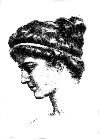Dr. Sarah's
Classroom Activities on Hypatia
I am teaching
Women and Minorities in Mathematics: A Course
with Significant Mathematical Content.
I am not a math historian - I am a geometer by training.
Please send comments or suggestions for improvement to
[email protected].

Day 1 on Hypatia
Intro to Hypatia - an overview
of her life and work by reading
the entry on Hypatia from Grinstein's Women of Mathematics.
Hypatia's work on
Ptolemy's Almagest.
Day 2 on Hypatia
Discuss errors in Osen's Women in Mathematics
entry on Hypatia,
Hypatia's work on Diophantus' Arithmetica,
and
Hypatia's work on Apollonius' Conics,
discuss classroom worksheets on Hypatia
(Famous Problems and Their Mathematicians by Johnson, p. 41-42,
Multicultural Science and Math Connections by Lumpkin, p. 146-
149,
Math Equals by Perl, p. 9-26).
Day 3 on Hypatia
Go over
Knorr's case that Hypatia worked on Archimedes, and go over the
proof of Archimedes dimension of the circle. Discuss
Dr. Sarah's worksheet (first draft) on Hypatia's possible work on
Archimedes dimension of the circle. For homework, students
are to do the worksheet and give suggestions for improvement.
Day 4 on Hypatia
WebCT quiz 2 on Hypatia's
mathematics and Mentoring poster.
Collect Hypatia worksheet
(first draft - which has errors in it) by Dr. Sarah.
Math Historian Edith Prentice Mendez' suggestions for
improvement of the worksheet
I think the "translated works" is misleading. To my knowledge, she worked
only in Greek, and the addition of
exercises is not authenticated.
Mary Ellen Waithe in "A History of Women Philosophers", vol 1,
came up with that. I think it would be more
accurate to say that Hypatia developed commentaries on older works,
probably of Ptolemy, Diophantus, and Apollonius. in place of Hypatia
>translated works, added exercises"
I'd give "Textual Studies" a citation and not give much credit to the Agnes
Scott site, though the author appears to have checked a number of sources.
I only skimmed this, but the stories are written by undergraduates and have
very mixed reliability.
In response to Dr. Sarah's query:
My understanding is that Wilbur found the sexigesimal computation that
he attributes to Hypatia in Ptolemy's book III, and then goes to other
sources (such as the medieval Arabic version of Dimension of the Circle)
and attributes them to Hypatia after seeing stylistic similarities.
Dr. Prentice Mendez wrote:
I think this is accurate--also based on the reputation Hypatia had for her
teaching and style, a reputation transmitted by extant letters by her
student Synesius.
Student suggestions for improvement of worksheet:
typos and comments for clarity, more pictures,
more space to write,
more guided help on the proof,
material was over the student's head / too hard
Student positive comments: (which weren't asked for)
This worksheet was helpful in allowing me to apply what I learned in
class - it gave me a better understanding.
pictures were helpful, as was the start of the proof,
I liked the worksheet.
Day 5 on Hypatia
Discuss student and math historian
Edith Prentice Mendez' suggestions for improvement of the worksheet
(see Day 4).
Discuss which suggestions where followed, which were not, and why.
Go over
Dr. Sarah's final version of
the Hypatia worksheet,
Microsoft Word 98 version
and solutions.

